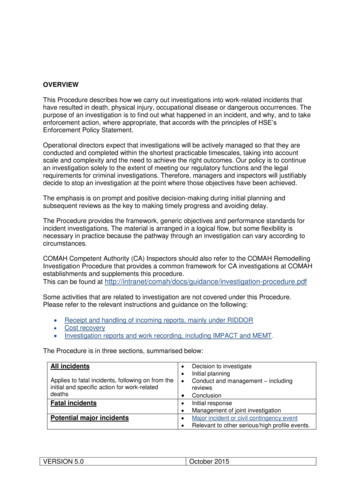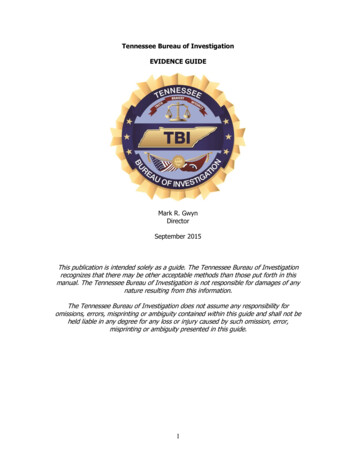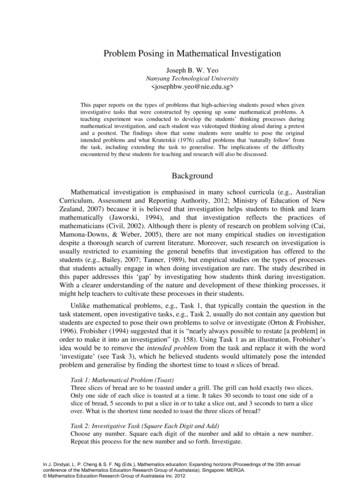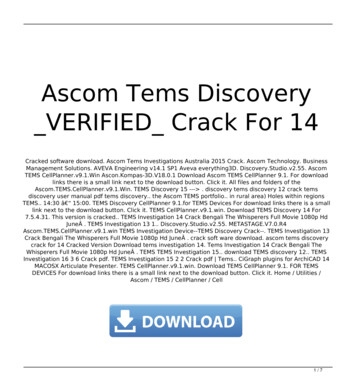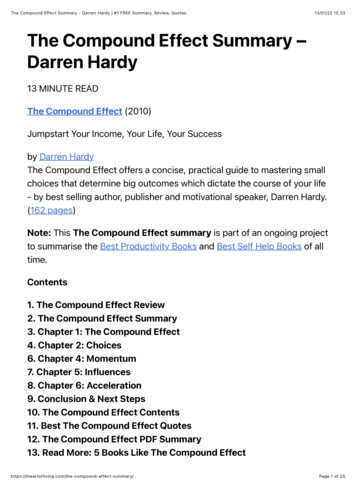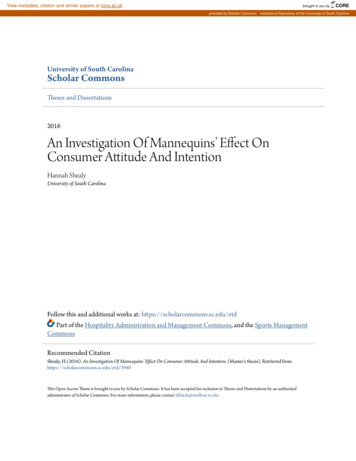
Transcription
View metadata, citation and similar papers at core.ac.ukbrought to you byCOREprovided by Scholar Commons - Institutional Repository of the University of South CarolinaUniversity of South CarolinaScholar CommonsTheses and Dissertations2016An Investigation Of Mannequins’ Effect OnConsumer Attitude And IntentionHannah ShealyUniversity of South CarolinaFollow this and additional works at: https://scholarcommons.sc.edu/etdPart of the Hospitality Administration and Management Commons, and the Sports ManagementCommonsRecommended CitationShealy, H.(2016). An Investigation Of Mannequins’ Effect On Consumer Attitude And Intention. (Master's thesis). Retrieved fromhttps://scholarcommons.sc.edu/etd/3940This Open Access Thesis is brought to you by Scholar Commons. It has been accepted for inclusion in Theses and Dissertations by an authorizedadministrator of Scholar Commons. For more information, please contact dillarda@mailbox.sc.edu.
AN INVESTIGATION OF MANNEQUINS’ EFFECT ON CONSUMER ATTITUDE ANDINTENTIONbyHannah ShealyBachelor of ScienceUniversity of South Carolina, 2015Submitted in Partial Fulfillment of the RequirementsFor the Degree of Master of Retailing inRetailingCollege of Hospitality, Retail, and Sport ManagementUniversity of South Carolina2016Accepted by:Jiyeon Kim, Director of ThesisJoohyung Park, Director of ThesisKhalid Ballouli, ReaderCheryl L. Addy, Vice Provost and Dean of the Graduate School
Copyright by Hannah Shealy, 2016All Rights Reservedii
ABSTRACTThis study examines the effect of mannequin type on consumers’ purchasedecisions. Data was collected from a convenience sample of 165 respondents through anonline survey to measure the variables of envisioning, consumer attitude toward thedisplay, and purchase intention in their relationship to mannequin type. Hypothesis 1, 2,and 3 were confirmed, confirming the conceptual model and the overall investigation intowhether mannequin type effects consumer purchase decisions. Mannequin type wasfound to have a significant effect on envisioning, and the relationships betweenenvisioning and consumer attitude toward the display and between attitude and purchaseintention were found to positively correlate. Although hypothesis 4 was not supported,and self-image congruence was found not to have a moderating effect on the relationshipbetween mannequin type and envisioning, it did have a main effect on envisioning.Overall, the study provides insight into the previously unstudied factor of mannequintype in consumer purchase decisions and provides a platform for further research andinvestigation.iii
TABLE OF CONTENTSABSTRACT . iiiLIST OF TABLES . viLIST OF FIGURES . viiCHAPTER 1 INTRODUCTION .11.1 JUSTIFICATION .3CHAPTER 2 REVIEW OF LITERATURE .42.1 VISUAL MERCHANDISING .42.2 MANNEQUINS .52.3 THEORETICAL BACKGROUND .7CHAPTER 3 RESEARCH MODEL AND HYPOTHESES .123.1 MANNEQUIN TYPE AND ENVISIONING .123.2 ENVISIONING AND CONSUMER ATTITUDE .133.3 CONSUMER ATTITUDE AND PURCHASE INTENTION .143.4 SELF IMAGE CONGRUENCE AS A MODERATOR .15CHAPTER 4 METHOD .184.1 RESEARCH DESIGN .184.2 SURVEY DESIGN .184.3 EXPLANATION OF MEASURES.21CHAPTER 5 ANALYSIS AND RESULTS .235.1 ANALYSIS .23iv
5.2 HYPOTHESIS TEST RESULTS .25CHAPTER 6 DISCUSSION .286.1 MANNEQUIN TYPE AND ENVISIONING .286.2 ENVISIONING AND CONSUMER ATTITUDE .306.3 CONSUMER ATTITUDE AND PURCHASE INTENTION .306.4 SELF-IMAGE CONGRUENCE AS A MODERATOR.31CHAPTER 7 LIMITATIONS AND FUTURE RESEARCH .337.1 LIMITATIONS .337.2 FURTHER RESEARCH .337.3 CONCLUSION .36REFERENCES .37APPENDIX A – SURVEY QUESTIONS .39APPENDIX B – EXPERIMENTAL CONDITIONS .42APPENDIX C – IRB APPROVAL .45v
LIST OF TABLESTable 2.1 Definition of Mannequin Type .7Table 4.1 Measurements .22Table 5.1 Respondents’ Gender and Age .24Table 5.2 Mean, Standard Deviation, and Correlation .27vi
LIST OF FIGURESFigure 3.1 Conceptual Model and Hypotheses .17Figure 4.1 Three Mannequin Types .20Figure 5.1 Self-image Congruence as a Moderator .26vii
CHAPTER 1INTRODUCTIONEvery time a customer shops, he or she is exposed to various sensory stimuli inthe store environment that may subconsciously affect the way he or she makes purchasedecisions. A significant amount of research has been done to understand this relationshipby identifying the stimuli that affect customer purchase decisions in-store (Sen, Block, &Chandran, 2002). Thus, many companies have begun learning how to tailor these stimuliin their stores to create a brand-appropriate store image and attract their customers to bothenter the store and make a purchase. Previous research findings suggest that visualmerchandising stimuli such as lighting, music, and smell affect consumers’ store choicebehavior and their buying behavior (Park, Jeon, & Sullivan, 2015). However, one of theseimportant stimuli, mannequins, have been overlooked in most studies despite their abilityto affect customer purchase behavior.Visual merchandising involves visual stimuli such as window display,mannequins, color presentation, signage, and lighting that can have a significant impacton customers (Lanjewar, 2014; Law, Wong, & Yip, 2012). Mannequins specifically havean ability to influence customers in a more direct way than the other stimuli by directlyshowing consumers how clothing looks on a human body and allowing them to envisionthemselves in the mannequin’s place. A consumer may be drawn to the clothing on themannequin, the way the clothing looks on the mannequin, or the mannequin itself1
(Schneider, 1997). Several studies have been conducted on the effectiveness ofmannequins on consumer purchase behavior and have found that consumers often look tomannequins first for style inspiration for how they should dress (Hefer & Cant 2013;Jain, Sharma, & Narwal, 2012). In these studies, participants in focus groups stated thatmannequins influence their decisions to purchase specific outfits by giving them ideas forputting together outfits, allowing them to picture the outfit on, and providing fitinformation (Hefer & Cant 2013; Jain et al., 2012). Mannequins have become animportant visual merchandising element in retail stores due to their ability to catch theeye of potential shoppers and visually provide fit and style information. Particularly inwindow displays, mannequins play a critical role in establishing a store’s brand identityin the mind of the consumer and triggering their interest in the store or a product, whichmay lead to a purchase (Park et al., 2015). However, there has been almost no researchdone on the different types of mannequins and their comparative effectiveness onconsumer purchase decisions. One of the leading textbooks on visual merchandising,Pegler (2006), breaks mannequins into categories by differing levels of realism. Based onPegler (2006), this study examines the effects of three different types of mannequinsrealistic, semi-realistic, and abstract- on apparel shoppers’ response. Realisticmannequins are the most traditional form and the most detailed, including full facialfeatures and minute details such as natural skin and hair colors. A semi-realisticmannequin is still humanistic but more exaggerated and decorative, for example, havingan unrealistic hair color or body color, while abstract mannequins are the least detailedand most artistic in form (Pegler, 2006).2
1.1 JUSTIFICATIONUnderstanding the various types and styles of mannequins available in today’sretail environments and their potential influences on consumers’ shopping experience iscritical. Despite the importance and ubiquitous usage of mannequins in the fashionindustry, there has been a lack of empirical research done on the different types ofmannequins and their comparative effectiveness. The purpose of this study is tounderstand different types of mannequins’ effect on customers’ purchase decisions.These findings will help the researcher discover whether one type of mannequin is moreinfluential on these consumers’ purchase decisions than others. Through this study,retailers can gain insight to their customer’s perspective and develop visualmerchandising strategies that enhance their customer’s loyalty and purchases.3
CHAPTER 2REVIEW OF LITERATURE2.1 VISUAL MERCHANDISINGVisual merchandising refers to the presentation of a store and its merchandisethrough the use of mannequins, layout, signage, and lighting (Lanjewar, 2014; Law et al.,2012). Consumers perceive these sensory stimuli in retail settings and respond based ontheir personal preferences. Visual merchandising places the merchandise in anaesthetically pleasing context and presents it in a way aimed at converting spectators intoprospective shoppers and ultimate buyers of the product (Park et al., 2015). Visualmerchandising displays are often referred to as a “silent sales person” because theyprovide consumers with information through visual mediums. A great deal ofcommunication takes place between the retailer and the consumer through the use ofvisual merchandising in terms of the store’s interior design, layout, atmospherics,merchandising, etc. (Hefer & Cant, 2013) The purpose of visual merchandising goesbeyond simply décor- it seeks to increase sales by drawing shoppers into the store with anenticing window display, then encourage them to remain in the store and purchase bycreating a positive experience with the interior layout and displays (Jain et al., 2012). Astudy by Law et al. (2012) illustrates the ability of visual merchandising to induce thedesired affective response of consumers and enhance purchase probability. According to4
their research, an effective visual design should consist of an appropriate degree of newand surprising elements in order to induce affective pleasure.In a focus group study by Hefer and Cant (2013), participants agreed that theirbuying behavior is influenced on a subliminal level based on the quality of visualmerchandising displays and their personal preferences. They stated that visualmerchandising displays aid in the final stages of their decision-making regarding thepurchasing of a specific product. In the end, the study found that when visualmerchandising displays are well designed and logical, the participants tended to beattracted to the section of products that were emphasized in the display, but personalpreferences such as color, textures, styles, sizes, budgetary constraints, etc. also have agreat effect on the buying behavior of the consumers (Hefer & Cant, 2013). In one studyexploring the impact of mannequins in visual merchandising, Jain et al. (2012) found that42% of women chose which store to enter in a mall based on their window displays. Thisstudy concluded that women in particular give a lot of attention to what product is beingdisplayed on mannequins and approximately 45% of the women surveyed said that theyoften get ideas of what clothing they would like to buy only after looking at themannequin displays.2.2 MANNEQUINSMannequins can be defined as “an assembled model of the human body used byretailers to demonstrate their products, especially to exhibit the draping of apparel” (Jainet al., 2012). The concept of mannequins is an ancient one, beginning with royalty usinglifelike sculptures to display their clothing and the common European practice in the5
1300’s of dressing dolls in miniature copies of the newest fashions to distribute toshoppers overseas in America. The modern idea of using a full-bodied mannequin forretail displays began in France in 1870 in the midst of the Industrial Revolution asmodern retailing practices began to develop. These first life-size mannequins werecreated to be a realistic interpretation of a human wearing the clothing and were made ofwax with false teeth, glass eyes, and real hair. Immediately, mannequins demonstratedtheir ability to attract and influence shoppers. One historian stated, “Such was the allureof the then-wax figures that window shopping quickly became a form of entertainment;millions came to stare at a make-believe world frozen in place” (d’Aulaire & d’Aulaire,1991). Over time, the use of the mannequin in retail displays spread all over the world,taking on many different styles and forms.Realistic mannequins are the most traditional form and the most detailed. Theyhave full facial features and are proportionally correct to resemble an average human,including even minute details such as natural skin and hair colors. A semi-realisticmannequin is typically proportioned and sculpted like a realistic mannequin but withdetails that are more exaggerated or decorative, for example, unrealistic hair color or anunnatural body color. Abstract mannequins are the most diverse category since they aremeant to be a humanoid decorative piece rather than a literal interpretation of a body.They often do not have to be proportionally correct or have any realistic color or definedfacial features (Pegler, 2006) (Table 2.1).6
Table 2.1Definition of Mannequin TypeMannequin TypeFacial FeaturesBody ColorBody ProportionsRealisticNatural skin colorAverage humanDefined facialfeatures, eye color,proportionshair color, and raceSemi-realisticVague features andUnnatural neutralAverage humanno clear eye color,color (e.g. white)proportionsDecorative colorExaggerated heighthair color, or raceAbstractNo facial features,eye color, hair color, (e.g. metallic)and length ofor defined raceappendages and/orslimmer thanaverage waist2.3 THEORETICAL BACKGROUND2.3.1 Envisioning“Envisioning” can be defined as consumers’ ability to imagine themselves in theclothing being displayed on a mannequin. Envisioning allows the customer to picturethemselves in the clothing as they view it on a mannequin, such that they rely on themannequin to visualize how the displayed clothes would look on their own body andinfer a degree of product fit (Lindström et al., 2015). In application to a retail setting,envisioning would refer to the extent to which customers are able to visualize themselveswearing an outfit displayed on a mannequin and how the displayed clothes would lookand fit on their own body. According to Anitha and Selvaraj (2010), mannequins provideshoppers with a visualization of whether the product is suitable for them. Lindström et al.7
(2015) conducted a study on the presence of mannequin heads’ influence on purchasedecisions and demonstrated that envisioning influences shoppers’ purchase intention.This study investigated one specific element of a mannequin, the presence or absence ofits head, and the consequent effect on consumers through two different experimentscomparing the difference in purchase intentions when viewing a headless versus a headedmannequin in-store and online, as well as investigating the consumer’s fashionknowledge as a moderating factor. The study found that the presence/absence of amannequin’s head directly influenced the consumers’ ability to envision themselveswearing the clothing being displayed.Studies like Lindström et al. (2015) emphasize the importance of envisioning invisual merchandising. Consider for a moment the presence of an abstract mannequin in adisplay. With its unrealistic proportions and color and lack of facial features, customersmay have trouble envisioning themselves personally wearing the clothing being displayedwhen looking at such an abnormal body type. It is also possible, however, that theabstractness of the mannequin may allow the customers the ability to mentally substitutethemselves in its place. Consider a different extreme- a realistic mannequin with correctbody proportions, hair color, eye color, and an identifiable race. One customer withsimilar features to the mannequin may see that mannequin, immediately acknowledgethat it resembles them and, as a result, can easily envision wearing the merchandise.However, a customer with a different hair color, race, etc. may see the same mannequinand immediately disqualify the product because they perceive it as “not for them”. Insituations such as these, the element of self-image comes into play. How a customerperceives oneself can immediately determine how they view a mannequin and their8
consequential purchase behavior (Cohen, 2014). This study will seek to compare how theamount of envisioning possible differs depending on mannequin type and to examine thismoderating effect of self-image.2.3.2 Conceptual FluencyAnother relevant theory in the field of visual merchandising is conceptualfluency. Lee and Labroo (2004) define conceptual fluency as “the ease with which aperson perceives and identifies the physical characteristics of a stimulus” and discuss itsimplication on retail branding. In other words, conceptual fluency asks whether astimulus fits or seems to belong in a certain context or background. The authorsdemonstrate that when a target comes to mind more readily and becomes conceptuallyfluent, as when it is presented in a predictive context or when it is primed by a relatedconstruct, participants develop more favorable attitudes toward the target. Lee andLabroo’s (2004) research specifically investigated word order and image order inadvertising messages and concluded that their participants’ attitudes toward a productwere more favorable when the product had been made more accessible in their memorythrough a predictive context, regardless of potential moderators like prior knowledge.They concluded through their experiments that conceptual fluency leads to morefavorable attitudes toward the product and may also lead to more favorable attitudestoward the brand itself, thus creating loyalty (Lee & Labroo, 2004).In a retail setting, this theory implies that clothing items come to mind morereadily and become conceptually fluent when the display matches the look of themannequin to the store’s brand image, causing shoppers to develop more favorableattitudes toward the clothing on the mannequin. It has yet to be investigated whether one9
kind of mannequin is more prone to produce conceptual fluency. Based on Lee andLabroo’s (2004) research, it can be assumed that mannequins are most effective ininfluencing consumers’ attitude when they fit with the consumers’ perception of thebrand. For example, due to their artistic nature, abstract mannequins are often associatedwith very high-fashion displays. It would feel very unnatural for consumers to observe ahigh-fashion abstract display in the window of a discount retailer because the displaywould not fit with the context of the consumers’ perception of the brand. This situationwould leave the shopper feeling uncomfortable and confused, not pleased and eager toshop the items featured in the display. Thus, considering the theory of conceptual fluencyis critical when retailers choose the mannequin type they will use in their displays since ithas such a strong influence on consumers’ attitude.2.3.3 Source SimilarityYet another theory important to consider in the effect of mannequin types onconsumer response is that of source similarity. “Source”, in this case, refers to a personwho tries to convey some messages to persuade audience, most likely measured as“attitude” toward to message, while “proximity” (or similarity) of the source group refersto how close – physically, emotionally, psychologically, or otherwise – a participant feelsto the source of information (Gopinath & Nyer, 2008). In one study, Gopinath and Nyer(2008) found that other members with close proximity to an individual have significantpower to persuade that individual, while a study by Simon, Berkowitz, and Moyer (1970)concluded that communicators (i.e. store mannequins) who are perceived as similar totheir audiences are more likely to affect persuasion and attitude change than thosesources who are seen as dissimilar.10
In visual merchandising, different types of mannequins could be considereddifferent types of sources with differing similarity or proximity to the consumer. Theprevious studies on source similarity (Gopinath & Nyer, 2008; Simon et al., 1970)suggest that a mannequin which a consumer perceives as similar or in close proximity tohimself would be more likely to persuade an individual and affect an attitude changetoward the displayed clothing. Thus, research could examine how the mannequins’differences affect customers’ responses (e.g., purchase intention etc.). Based on thistheory, it could be assumed that realistic mannequins who appear similar to a consumerwould be the most influential in affecting an attitude change. However, since allindividual consumers look unique, it would be impossible for a retailer to use realisticmannequins that resemble all of their potential customers. The challenge for retailers liesin how to use the principles from this theory and find a mannequin that a wide group ofcustomers could perceive as similar to themselves to best influence their purchasebehavior. The theory of source similarity works together with the concepts of envisioningand conceptual fluency to support this paper’s objective to investigate how the differingtypes of mannequins affect customer purchase decisions.11
CHAPTER 3RESEARCH MODEL AND HYPOTHESES3.1 MANNEQUIN TYPE AND ENVISIONINGAny mannequin in a display will, to some degree, allow for envisioning. Thepreviously mentioned research that has been conducted on the effectiveness ofmannequins on envisioning seems to suggest that mannequins with more realistic featuresand proportions have the ability to positively affect consumer purchase decisions. (Anitha& Selvaraj, 2010; Cohen, 2014; Lindström et al., 2015). While clothing retailers usuallyuse mannequins with idealized, rather than average, body-types and proportions, Sen etal., (2002) suggests that in order to communicate the true fit and look of the item tocustomer it would be better to use realistic mannequins that more closely reflect thedimensions and proportions of the store’s major target market. Similarly, Anitha andSelvaraj (2010) conclude that people can envision themselves in outfits worn bymannequins only if they can relate to the mannequin, suggesting that semiabstract andabstract mannequins may not be as successful as a more realistic mannequin type inencouraging customer purchases. However, it could also be argued that a mannequin thatis too realistic will inhibit a customer from envisioning because the mannequin’s featuresare too different from the customer’s own and the customer can no longer relate to themannequin. Because of this, the moderating effect of self-image congruence must also be12
considered when investigating the relationship between mannequin type and envisioning.Increasing a customer’s ability to envision is critical for retailers since it is theorized thata stronger ability to envision wearing the merchandise will translate into greater purchaseintentions for merchandise displayed (Sen et al., 2002). These previously mentionedstudies suggest that a consumer’s ability to envision is partially determined by the type ofmannequin being used. This study seeks to understand whether different mannequin typeswill affect consumers’ ability to envision.H1- Different types of mannequins have different influences on envisioning.3.2 ENVISIONING AND CONSUMER ATTITUDEThe next relationship that must be considered is the one between envisioning andconsumers’ attitude. Attitude in this case can be defined as the degree of affectiveresponse elicited by visual merchandising (Anitha & Selvaraj, 2010). The studiesconducted by both Sen et al. (2002) and Anitha and Selvaraj (2010) discuss envisioning’sability to influence consumers’ thoughts about the display and merchandise as well astheir ultimate purchase decisions, so it is understood that envisioning would be capable ofaffecting consumers’ attitudes. The previously mentioned theory of source similarity, theidea that communicators who are perceived as similar to their audiences are more likelyto affect attitude change, supports this hypothesized relationship between envisioning andattitude (Gopinath & Nyer, 2008). Based on this theory, if a consumer can relate to amannequin as similar to himself, he will not only be able to envision himself in theclothing but will also develop a positive attitude toward the clothing due to his perceivedconnection to the mannequin. Thus, consumers’ self-image congruence and envisioningplay a direct role in the consumers’ attitude. Based on the previous research, it can be13
seen that mannequins have the ability to influence consumers’ thoughts about the displayand merchandise as well as their ultimate purchase decisions (Anitha & Selvaraj, 2010;Sen et al., 2002). This study will seek to discover whether a consumer’s attitude toward adisplay will be positively affected by their ability to envision.H2- Envisioning is positively associated with consumer’s attitude toward thedisplay.3.3 CONSUMER ATTITUDE AND PURCHASE INTENTIONFinally, the customers’ attitude toward the display can play an important role inpurchase decisions. Attitude, the affective response elicited by visual merchandising,often influences behavior in the form of shopping style and purchase intention. Purchaseintention can be defined as simply the willingness of a customer to buy a certain product.A study by Park et al. (2015) hypothesized that visual merchandising cognition effectsbrand salience and attitude toward visual merchandising, which in turn effects consumerattitude toward the display. This study concluded that environmental factors such asvisual merchandising may impact consumers’ internal responses, and subsequently thoseresponses affect consumer behavior. Park et al. (2015) found that consumers are morelikely to purchase if they have a favorable attitude toward the brand and claimed that aconsumer’s perception of a brand is key to the formation of their purchase intention. Astudy by Law et al. (2012) asserted that the degree of consumer response to stimuli isinteractive and hypothesized that positive influences on consumer attitude toward thedisplay can affect purchase behavior in terms of involvement, time spent in the store, etc.and can even encourage spending. This study seeks to understand whether positiveconsumer attitude toward the display can increase consumers’ purchase intentions.14
H3- Consumer’s attitude toward the display will positively affect the purchaseintention of the clothing/merchandise on display.3.4 SELF-IMAGE CONGRUENCE AS A MODERATORThe relationship between the mannequin type and envisioning is often moderatedby the shopper’s self-image. Self-image congruence refers to similarity of consumers'perceptions of themselves and the “personality” of a given product, brand, store, or in
visual merchandising in terms of the store's interior design, layout, atmospherics, merchandising, etc. (Hefer & Cant, 2013) The purpose of visual merchandising goes beyond simply décor- it seeks to increase sales by drawing shoppers into the store with an enticing window display, then encourage them to remain in the store and purchase by





